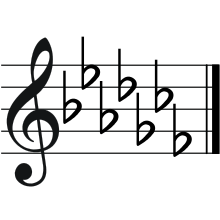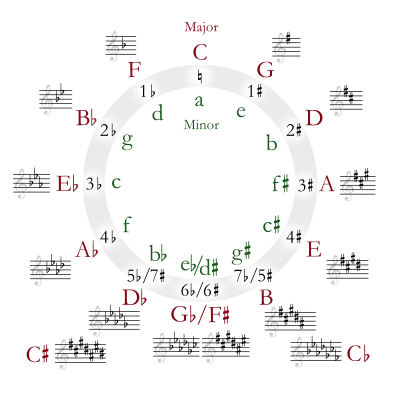C-flat major
 | |
| Relative key |
A♭ minor enharmonic: G♯ minor |
|---|---|
| Parallel key |
C♭ minor enharmonic: B minor |
| Dominant key |
G♭ major enharmonic: F♯ major |
| Subdominant |
F♭ major enharmonic: E major |
| Enharmonic | B major |
| Component pitches | |
| C♭, D♭, E♭, F♭, G♭, A♭, B♭, C♭ | |
C♭ major is a major scale based on C♭, consisting of the pitches C♭, D♭, E♭, F♭, G♭, A♭, and B♭. Its key signature has seven flats.
C♭ major is the only major or minor key, other than theoretical keys, which has "flat" or "sharp" in its name, but whose tonic note is the enharmonic equivalent of a natural note (a white key on a keyboard instrument).
Its relative minor is A♭ minor (or enharmonically G♯ minor), and its parallel minor is C♭ minor, usually replaced by B minor, since C♭ minor's three double-flats make it generally impractical to use.
The direct enharmonic equivalent of C♭ major is B major, a key signature with five sharps.
C♭ major is the home key of the harp, with all its pedals in the top position, and it is considered the most resonant key for the instrument. Thus, in Richard Strauss's Ein Heldenleben, the first cue for the harps is written in C♭ major even though the rest of the orchestra, having previously played in E♭ major, retains a 3-flat key signature and is now playing in B major, marked with the necessary sharps and naturals as accidentals. This use of C♭ major in harp parts when the rest of the orchestra is playing in B major is not exceptional: it is standard practice in orchestral music written in B major for harp parts to be notated in C♭ major. In Arnold Bax's symphonic poem Tintagel, the key is B major and again the harp part is always notated in C♭ major; but in this case the harp's key signature contains only 6 flats, and the necessary F♭s are notated with accidentals. In Claude Debussy's Sonata for Flute, Viola and Harp, the second movement has a middle section in B major, for which the harp part is notated in C♭ major with seven flats. In Reinhold Glière's Harp Concerto in E-flat, the middle movement is a set of variations in C♭ major.
Sometimes harp parts are also written in G♭ major when the rest of the orchestra is notated in F♯ major. This style of enharmonic notation for harp parts is somewhat less common when the principal key involved is a minor one.
The middle section of Frédéric Chopin's Contredanse in G♭ major is written in C♭ major, as are the middle (Trio) sections of two of Ernesto Nazareth's Brazilian tangos for piano, "Chave de Ouro" and "Labirinto" (both with a home key of G♭ major), as well as the final half (last two themes) of William Bolcom's rag for piano, "Seabiscuits".
There is a brief passage in the first movement, "Evocación", of Iberia by Isaac Albéniz which suggests the key of C♭ minor by adding the necessary double-flats as accidentals. The surrounding passages are in C♭ major, with a 7-flat key signature. The movement is in sonata form, in the key of A♭ minor, so this places the second theme in the orthodox relative major key (and in the also-orthodox tonic major key of A♭ major when it reappears near the end of the piece).
The slow movement of Ludwig van Beethoven's Piano Sonata No. 12 has a principal theme that modulates from A♭ minor to C♭ major, before moving to what would theoretically be C♭ minor, but is notated as B minor (every note in this passage requires an accidental, due to the key signature of seven flats). A number of other works by Beethoven have significant passages in C♭ major, although they usually notate this with accidentals in some other key signature, seldom a 7-flat key signature: for example, Symphony no. 9 in D minor, Op. 125 (Choral), 3rd movement - the section containing a prominent horn solo before the final return of a variant of the first theme, back in B♭ major; Piano Sonata no. 26 in E♭ major, Op. 81a ("Les Adieux") - several bars into the slow introduction to the first movement; Piano Sonata no. 31 in A♭ major, Op. 110 - last movement, first appearance of the Arioso section: it is in A♭ minor (despite being notated with only 6, not 7, flats), and this includes a significant modulation to its relative major key of C♭ major; Piano Concerto no. 5 in E♭ major, Op. 73 ("Emperor") - one of the transitional themes in the first movement's exposition section, between the first and second subjects.
C♭ major is used for Benjamin Britten's Interlude in C♭ major for harp, several of Max Reger's Canons in All Major and Minor Keys (Book 1 Nos. 62 and 63, and Book 2 No. 48), and No. 29 from the Thirty Preludes in All Major and Minor Keys by Christian Heinrich Rinck.
In some scores, the C♭ major key signature in the bass clef is written with the flat for the F on the second line from the top. This can be seen, for example, in the Albéniz example given above: Iberia, 1st movement: "Evocación", about two-thirds of which is in 7 flats, and every bass-clef staff of which shows this variant.
References
External links
| Diatonic scales and keys | |||||||||||||||||||||||||||||||||||||||||||||||||||||||
|---|---|---|---|---|---|---|---|---|---|---|---|---|---|---|---|---|---|---|---|---|---|---|---|---|---|---|---|---|---|---|---|---|---|---|---|---|---|---|---|---|---|---|---|---|---|---|---|---|---|---|---|---|---|---|---|
 |
| ||||||||||||||||||||||||||||||||||||||||||||||||||||||
| The table indicates the number of sharps or flats in each scale. Minor scales are written in lower case. | |||||||||||||||||||||||||||||||||||||||||||||||||||||||